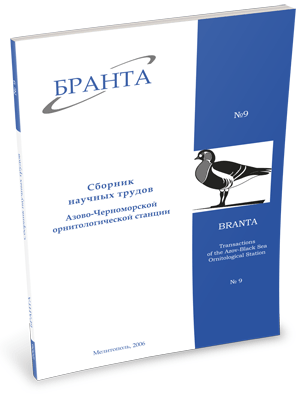
Transactions
of the Azov-Black Sea Ornithological Station



Results of the first large census of wintering birds in zonal landscapes of South Ukraine
Andryushchenko Yu., Chernichko I., Kinda V. et al.
The paper presents results of the bird census conducted on 8-15 February 2001 in South Ukraine (south-east of Kherson region,south of Zaporizhzhia region, south-west of Donetsk region and the steppe Crimea). In contrast to traditional counts of waterbirds for this region, these counts were carried out chiefly in a zonal landscape and their period was not determined by a special date, but connected with establishing of winter weather in the region. Apart from remained steppe areas (virgin lands or used as pastures and grasslands) this paper consider zonal landscapes as any landscape elements of Ukrainian dry steppe zone: fields of agricultural crops (including fallow lands, arable lands, idle/abandoned fields), forest plantations (field-protective belts, gardens, vineyards, parks, artificial forests), small villages. These areas have a characteristic type of snow cover in winter. I f to the south of a conditional line, crossing Kakhovka, Vesyoloye, Berdyansk, the average snow depth in January usually does not exceed 10 mm; permanent snow cover is observed lesser than during 50% of winters, in winter period there are not more than 150-175 mm of precipitation,partly rain (Atlas of natural conditions..., 1978). I t makes food more available for bird species feeding on land or chiefly on land, either for phytophages or predators. As a consequence, when the winter weather established in the region, many of birds form considerable concentrations. So, the winter weather in the Azov-Black Sea region of Ukraine can be considered as the presence of both negative temperatures and snow cover. At this, mostly to the north, north-east and east of the above-mentioned conditional line there forms a relatively deep snow cover, displacing many wintering birds species from these territories to the south, in a dry steppe subzone of Ukraine.
Materials and methods
Before starting the counts the whole territory was divided into 304 squares with the size of 10x10 km (100 km2). The counters formed 8 groups; each of them investigated 50-60 squares. During a day one group investigated from 4 to 8 squares, depending on weather conditions (visibility, trafficobility), presence and areas of localities, agricultural objects, water bodies. Counts were selectively carried out in some localities. To make a comparative analysis of the count results the investigated area was conditionally divided into 3 parts taking into account physical-geographic division of Ukrainian steppe zone: Northern part, Central and Southern. A total area of the investigated territory was about 30,400 km2, and therefore this collected material is original and highly valuable to understand bird wintering in zonal landscapes of South Ukraine.
Results and discussions
In a total 994,340 individuals of 105 bird species were recorded. The most numerous were (species are listed according to decrease of quantity of squares where these species were observed) Magpie (144 squares), Reed Bunting (142), Hen Harrier (109), Rough-legged Buzzard (90), Great Bustard (90), Raven (84), Carrion Crow (69), Kestrel (67), Calandra Lark (64), Mallard (62), Starling (60), Rook (59), Sparrow-hawk(58) and Skylark (56). All of these species, excepting Mallard and Bustard relate to daylight birds of prey or to passerines. Waterbirds contained above 62% of all counted birds and related to more than 43% of all observed species. Of them apart from Mallard (species are listed according to decrease of quantity of squares where these species were observed), only Mute Swan, Great White Egret, Common Shelduck, Common Heron, Common Gull, Graylag Goose and Yellow-legged Gull were recorded in more than 20 of 304 squares, and mainly on large water bodies and along them. However, majority of waterbirds, 31 of 46 species were observed not more than in 10 squares. Therefore, data on these species distribution mostly show importance of small continental water bodies for their wintering than that of open water areas of seas and their bays.
Conclusion
Large-scale counts o f birds in February 2001 were quite representative, including estimation of value of zonal landscapes for wintering birds. Comparison of numbers and distribution of individuals between zonal and "wetland" squares demonstrated the selectivity of some species or higher taxa to various types of landscapes. So, concentration of 82.1% of Rough-legged Buzzard in squares with prevalence of zonal landscapes is rather natural, but records of 51.7% of White-tailed Eagle in these squares gives new value of a continental part of the region for this species distribution, as earlier it was traditionally considered as the species wintering chiefly at large water bodies. In contrast to this, counts of most waterbirds in zonal squares do not give a picture of real numbers of their wintering populations. Exceptions are Graylag Goose and White-fronted Goose, majority of which are in "zonal" squares. Apart from these geese species, counts conducting out of borders of large wetlands also are o f great importance for such waterbirds as Mallard (among ducks), Common Gull (among gulls), and Little Grebe (among other waterbirds). These species can be recommended as model species for monitoring of wintering areas of waterbirds in zonal landscapes of South Ukraine.
The obtained results are a convincing proof for conducting similar counts regularly not only in southern part of East Ukraine, but in much more extensive area. The coverage of considerable areas by great number of counters will allow not only estimate distribution and numbers of wintering birds, but find out the reasons of such distribution, which frequently he out of borders of a small investigated area. So, explanation of bird wintering in one relatively limited area in terms of established conditions (above all, weather), will be also proved by data from neighboring areas or regions, where other conditions caused movements of birds to these territories or in the reverse direction.
Read the paper in a PDF file